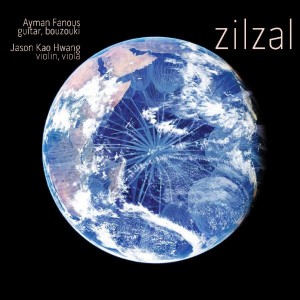CD reviews by Matt Cole
Two recent releases from Innova Recordings, the record label of the St. Paul-based American Composers Forum, while having very different lineups (one an octet, the other a duo), provide fine examples of musical patience and communication.
 Artist: Peter Kerlin Octet
Artist: Peter Kerlin Octet
Title: Salamander
Label: Innova Rec
Genre: jazz/new music/Collection: chamber, double bass, funk, music for dance & soundtrack
Salamander is the debut album from bassist/composer Peter Kerlin. The five pieces on the roughly 40-minute album are scored for two vibraphones (Sam Sowydra and Cesare Papetti), two basses (Kerlin, joined by Taylor Bergren-Chrisman and Brent Cordero), organ (Emily Manzo), drums and percussion (Mike Pride and Charles Burst), and viola (Amy Cimini, Jessica Pavone, and Karen Waltuch).
Kerlin uses a range of compositional techniques on Salamander, ranging from the composed “Bulbs” and “Snake Eats Electric Blanket” (there are some pretty good track titles on this album) to the group improvisation of “Ballad of the Bewildered Herd.” “Bulbs” starts the album, opening with a syncopated, funky mid-tempo bass groove soon joined by ominous viola. The music builds patiently, a running theme for Salamander, to a cohesive groove of interlocking parts, interacting nicely. The vibraphone playing here and elsewhere provide a mood reminiscent of Peter Buck’s instrumental project Tuatara, which featured, among others, wildly creative saxman Skerik and percussion master Elizabeth Pupo-Walker; and Manzo’s organ sound reminded me of proto-prog bands The Nice (Keith Emerson’s pre-ELP project) and King Crimson. “Bulbs” as a whole provides the first example of the Octet’s ability to change on a dime, effortlessly shifting mood, feel, and instrumentation.
Next up, “Snake Eats Electric Blanket” is a full-on soundscape of interlocking rhythms and sounds, which again develops over time, sometimes with an avant-’60s vibe (here in particular I heard a more hypnotic, drony hint of King Crimson), at other times being flat-out danceable, albeit not in an overpriced meat-packing-district nightclub sort of way (maybe more like a slightly demented-in-a-good-way jig.) Even more diverse in its influences is “Cenozoan Warp,” in which I heard everything from Webern- and Varese-inspired viola to jazzy vibraphones, all developing very deliberately (but interestingly enough to keep a reasonably attentive listener engaged and entranced) and with the many layers interesting in and of themselves while combining to make a cohesive whole.
The shortest piece on the album, “Wanna Let the Bell-Tower Ring,” might also be the most humorous, starting out with a jazzy crime feel somewhere between light noir and Pink Panther, but a little more outside and dissonant. The band then melts, while maintaining the swing, explicitly or implicitly, before going elsewhere and then coming back, all punctuated by occasional percussive explosions (a trend that would continue on the next and final track).
“Ballad of the Bewildered Herd” is the last and longest piece on the album, and feels like a culmination of the entire work. Overall, space jazz is probably the best descriptor of “Bewildered Herd” as a whole. Throughout, we are treated to a full range of bass techniques ranging from intense arco to rapid, chordal plucking, but all in service to the music. The percussionists place their hits and explosions well, and the viola weaves a sinuous dancer into the center of the proceedings. As the players join in and intensify, it becomes very obvious that these musicians are filling up a lot of aural terrain without ever making it feel crowded; minding each other’s space, listening intently, and playing off of each other in many dimensions. As the music builds and expands, the details become more out and dissonant, but the overall shape of the piece remains hopeful, a continuous wave of growth, before ending on a repeated unison figure shared by the vibes, viola, and an arco bass.
 Artist: Ayman Fanous and Jason Kao Hwang
Artist: Ayman Fanous and Jason Kao Hwang
Tirle: Zilal
Label: Innova Rec
Genre: experimental jazz
When first I listened to Zilal (Arabic for “earthquake”), the new album from Ayman Fanous (guitar and bouzouki) and Jason Kao Hwang (violin and viola), having not read anything about it so as to keep my mind open, I wondered to what extent it was composed, and to what extent it was improvised, as the two musicians were extremely tight and attuned to each other, interacting and communicating to an extent that is rare even among experienced improvisers (and would suggest at least some writing, or at least prior shaping), but the music had a level of detail and whimsy that would make it quite difficult to write out in full. As it turns out, Fanous and Hwang have been playing together for over a decade and a half, and played these pieces with no prior planning; given the overall coherence of the individual pieces and the album as a whole, this is quite a remarkable feat.
Fanous and Hwang bring a variety of influences to the music, notably flamenco and classical guitar in Fanous’ case, and thus it’s not surprising that like Salamander, Zilal has a diversity of influences and sounds; this is especially notable given that as a duo there are only two instruments playing at any time. Fanous’ playing ranges from overtones, to flamenco sounds, to rapid runs alternating with well-used silence, and even moves his strumming/picking hand around to play with his guitar’s timbre. Hwang makes full use of the techniques and methods in his toolbox, ranging from drones to double stops, rapid runs to stark and spacy pizzicato; and manages a diverse set of timbres, at one point (“Nilometer at Roda”) sounding almost like a bass clarinet and later having a hint of flute (“Tree of the Virgin at Matariya”). None of this feels like the musicians are showing off, rather, they’re maximizing the sonic possibilities of the music that they’re spontaneously creating (very important in a duo recording). The communication between the two is almost spooky; as they effortlessly switch between the lead/forefront and backing, and support each other’s playing unusually well. During “DNA: Messenger, the Message” the rapid picking and angular, interlocking lines felt like a frenetic Mediterranean conversation, with the two instruments overlapping, but listening and responding to each other.
Some of the other influences and styles I heard on this album included hints of Persian music and blues in “Nilometer at Roda,” guitar movements like a hummingbird in the title track “Zilal” (which also included Kwang’s neat trick of making ’80s robot-sounding noises with his violin, noises which sounded very organic and alive), the Gypsy and flamenco sounds of “Mausoleum of Beybars the Crossbowman” and “Tree of the Virgin at Matariya,” hints of Webern, Messiaen, and Varese in the violin in “DNA: Untranslated” and “Darb al-Arbaeen,” and some rapid, almost Les Claypool-esque chords in “Lapwing.” The last two also provide great examples of the unexpectedly logical and seamless transitions within pieces, and overall within the album, which help to allow the duo to tell an abstract and coherent story.
These two albums from Innova may on the surface seem different, what with their different instrumentations and sizes, and different approaches. The net results, though, are in many ways similar, as both bands develop their music with patience and care, building soundscapes and stories out of interlocking parts, listening and communicating attentively and paying attention to space, whether duo or octet. These albums will reward patience and careful listening, the music at times playing with subtlety and space, then building or seamlessly transitioning to exciting and intricate energy.

